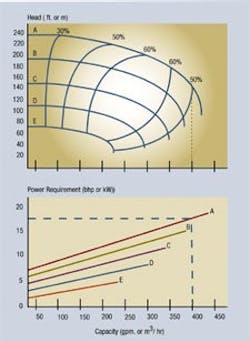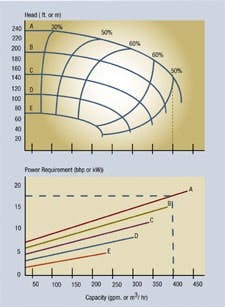Electric motors operate at their peak power factor and efficiency when fully loaded. So, you do not want to purchase a motor that is too big; common sense dictates that one that is too small is even worse. A few simple steps will help you select the right motor for your centrifugal pump application.Let's assume that the pump performance curve shown in the figure represents the pump that needs a motor. The first thing we must do is decide what diameter impeller to use. The figure shows impeller diameters from "A" to "E." The curves are marked with letters rather than numbers so that we can work the examples in either metric or English units.For this example we will use impeller size "A." To determine the maximum capacity for your pump, select the last efficiency line at the right-hand side of the top curve. For this particular pump, that would be the 50% line. You don't want to read off the line any further to the right, since the pump will likely cavitate in this region of operation.The capacity at this point is 400 gpm or m3/hr. Using the bottom curve, determine the energy required by the pump in either brake horsepower (bhp) or kilowatts by finding the point for 400 gpm or m3/hr for impeller size "A." According to the figure, the pump motor will use about 17 bhp or kW at this capacity.The specific gravity of the fluid being pumped is assumed to be 1 (like fresh water). Electric motors are sized considering the specific gravity of the liquid being pumped. If a low-specific-gravity pump is tested with water, or any higher-specific-gravity fluid, the increase in motor amperage could burn out the motor.If the actual fluid has a higher or lower specific gravity than water, we must multiply the number on the Y-axis of the bottom curve by the specific gravity of the fluid to get the correct energy requirement for the application.If the pump is sized correctly, it will run within 10% of its best efficiency point. For impeller size "A," that would be about 325 gpm or m3/hr (as shown in the figure). So, we can take advantage of the pump service factor to give us the needed horsepower should the pump occasionally run at the maximum capacity (400 gpm or m3/hr) or get into any other temporary overload condition, such as starting while rotating backward.Service factor ratings
The pump service factor rating is supplied by the motor manufacturer and is usually available in three ranges:* A service factor of 1.00 to 1.10; most motors that have these low ratings are older, and a majority of them have undesirable aluminum windings.* A service factor of 1.15; this is the most common service factor used in modern motors.* A service factor of 2.00 to 2.50; these motors are seldom in stock and are built at a premium price.Motors are available in a variety of power ratings. Typical horsepower ratings would be: 0.5, 1.0, 1.5, 2.0, 3.0, 5.0, 7.0, 10, 15, 20, 30, etc.Our graph shows that we need a 17-hp motor, but a 15-hp motor will work in this application because of the service factor (15 hp 3 1.15 = 17.25 hp available). Had the graph showed we needed an 18-hp motor, however, we would have had to opt for a 20-hp motor. Keep in mind that the manufacturer's heat generation computations were made for the motor when it was running at its rated horsepower and not at the service factor rating. All this means is that the motor will run hotter than anticipated, but still within acceptable limits.
The pump service factor rating is supplied by the motor manufacturer and is usually available in three ranges:* A service factor of 1.00 to 1.10; most motors that have these low ratings are older, and a majority of them have undesirable aluminum windings.* A service factor of 1.15; this is the most common service factor used in modern motors.* A service factor of 2.00 to 2.50; these motors are seldom in stock and are built at a premium price.Motors are available in a variety of power ratings. Typical horsepower ratings would be: 0.5, 1.0, 1.5, 2.0, 3.0, 5.0, 7.0, 10, 15, 20, 30, etc.Our graph shows that we need a 17-hp motor, but a 15-hp motor will work in this application because of the service factor (15 hp 3 1.15 = 17.25 hp available). Had the graph showed we needed an 18-hp motor, however, we would have had to opt for a 20-hp motor. Keep in mind that the manufacturer's heat generation computations were made for the motor when it was running at its rated horsepower and not at the service factor rating. All this means is that the motor will run hotter than anticipated, but still within acceptable limits.
The pump performance curve shows that the maximum capacity for impeller size "A" is 400 gpm or m3/hr. A motor for this pump should be rated at 17 bhp or kW.API requirements
Oil refinery applications use a second factor recommended by the American Petroleum Institute (API). This organization specifies that the factor should be used as an additional safety margin. These factors are:* Up to 25 hp (18.7 kW) = 1.25* From 30 hp to 70 hp (22.4 kW to 52.2 kW) = 1.15* 100 hp (74.6 kW) or higher = 1.10If we take the same example as noted above and insert the API additional requirement, we come up with 17 hp 3 1.25 (API specification) = 21.25 hp needed.There are instances in which you can combine the two service factors to find a compromise.As an example, suppose that the power requirement was 8.7 hp. According to API, you would need 8.7 hp 3 1.25 = 10.8 hp. In this case, you would have to buy a 15-hp motor because there are no motors available in between 10 and 15 hp. But, a new pump will likely have a service factor rating of 1.15. For the 10-hp motor, this would mean 10 hp 3 1.15 = 11.5 hp. Since this is more than the 10.8 hp recommended by API, you can buy the 10-hp motor, rather than the 15-hp motor, and satisfy the API requirement.When choosing a motor for a centrifugal pump, you must consider the impeller size, maximum capacity, specific gravity of the fluid, and service application in case API requirements apply. If you take these things into account, you will select the right motor for your centrifugal pump application. William McNally has more than 45 years of experience with pumps and seals. He runs the McNally Institute, which conducts courses on pumps and seals.
Oil refinery applications use a second factor recommended by the American Petroleum Institute (API). This organization specifies that the factor should be used as an additional safety margin. These factors are:* Up to 25 hp (18.7 kW) = 1.25* From 30 hp to 70 hp (22.4 kW to 52.2 kW) = 1.15* 100 hp (74.6 kW) or higher = 1.10If we take the same example as noted above and insert the API additional requirement, we come up with 17 hp 3 1.25 (API specification) = 21.25 hp needed.There are instances in which you can combine the two service factors to find a compromise.As an example, suppose that the power requirement was 8.7 hp. According to API, you would need 8.7 hp 3 1.25 = 10.8 hp. In this case, you would have to buy a 15-hp motor because there are no motors available in between 10 and 15 hp. But, a new pump will likely have a service factor rating of 1.15. For the 10-hp motor, this would mean 10 hp 3 1.15 = 11.5 hp. Since this is more than the 10.8 hp recommended by API, you can buy the 10-hp motor, rather than the 15-hp motor, and satisfy the API requirement.When choosing a motor for a centrifugal pump, you must consider the impeller size, maximum capacity, specific gravity of the fluid, and service application in case API requirements apply. If you take these things into account, you will select the right motor for your centrifugal pump application. William McNally has more than 45 years of experience with pumps and seals. He runs the McNally Institute, which conducts courses on pumps and seals.
About the Author
William McNally
William McNally
Sign up for our eNewsletters
Get the latest news and updates

